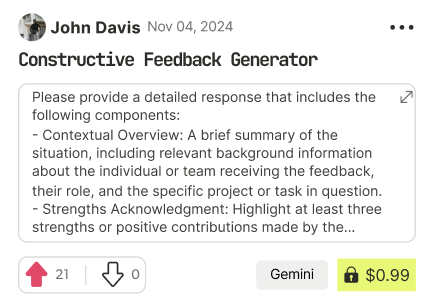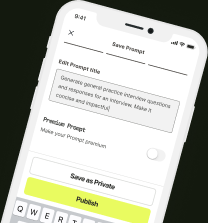prompt mine App
Find, Create & Share AI Magic
10-Step Social Media Marketing Plan for Small Businesses
## 10-Step Social Media Marketing Plan for Small Businesses
This plan focuses on practical, actionable steps a small business can take to build a strong social media presence.
**1. Content Strategy: The "Entertain, Educate, Engage" Approach**
A successful content strategy balances different types of content to keep your audience interested and involved.
* **Entertaining (30%):**
* **Formats:** Short, engaging videos (TikTok-style), behind-the-scenes photos, funny memes/gifs related to your industry, lighthearted polls.
* **Example:** A local bakery posting a funny video about their "Monday morning blues" when the coffee machine breaks, using related trending sounds.
* **Educational (40%):**
* **Formats:** Blog posts (repurposed into social media snippets), infographics, how-to videos, industry news updates, FAQs.
* **Example:** A landscaping company posting a blog post on "5 Common Lawn Care Mistakes" and sharing snippets with visuals across social media.
* **Promotional (30%):**
* **Formats:** Product/service announcements, special offers, customer testimonials, success stories, behind-the-scenes looks at product development.
* **Example:** A local bookstore announcing a 20% off sale on new releases with a visually appealing graphic and a clear call to action (shop now!).
**2. Content Creation Guidelines: Platform-Specific Approach**
* **Facebook:**
* **Tone:** Friendly, informative, and community-focused.
* **Style:** Longer posts with compelling visuals (photos and videos). Encourage discussions in the comments.
* **Frequency:** 3-5 posts per week.
* **Example:** Share blog post links, announce events, post customer testimonials, ask questions to spark conversation.
* **Instagram:**
* **Tone:** Visual, inspiring, and aspirational.
* **Style:** High-quality photos and videos, using Instagram Stories for behind-the-scenes content.
* **Frequency:** 5-7 posts per week (including Stories).
* **Example:** Showcase products beautifully, use Instagram Reels for short, engaging videos, run polls and quizzes on Stories.
* **Twitter:**
* **Tone:** Concise, informative, and engaging.
* **Style:** Short, punchy tweets, using relevant hashtags. Participate in industry conversations.
* **Frequency:** 5-10 tweets per day (or more).
* **Example:** Share industry news, comment on trends, run short polls, retweet relevant content from others.
**3. Content Creation Tools and Workflow:**
* **Free Tools:** Canva (graphic design), Pexels/Unsplash (stock photos), CapCut (video editing), Later/Buffer (social media scheduling).
* **Workflow:**
1. Brainstorm content ideas monthly based on the "Entertain, Educate, Engage" framework.
2. Create a content calendar outlining post dates, platforms, and content formats.
3. Batch create content (e.g., write several blog posts in one sitting).
4. Schedule posts using a social media scheduling tool.
5. Monitor engagement and respond to comments.
**4. Engagement Techniques: Sparking Conversation & Building Relationships**
* **Respond Promptly:** Acknowledge and respond to comments and messages within 24 hours. Show that you value your audience's input.
* **Use Relevant Hashtags:** Research industry-specific and trending hashtags to increase visibility. Use a mix of broad and niche hashtags.
* **Run Contests & Giveaways:** Offer prizes related to your business. Require participants to follow your page, like/share a post, or tag friends.
* **Ask Questions:** Encourage interaction by posing questions in your posts.
* **Run Polls & Quizzes:** Use platform-specific features to engage your audience in a fun and interactive way.
* **Partner with Influencers:** Collaborate with local influencers or those relevant to your niche to reach a wider audience.
**5. Audience Growth Strategies:**
* **Run targeted ads:** Use Facebook/Instagram Ads to reach new potential customers based on demographics, interests, and behaviors.
* **Cross-promote:** Share your social media profiles on your website, email signature, and other marketing materials.
* **Engage with other accounts:** Follow, like, and comment on accounts that are relevant to your niche or target audience.
* **Host or Participate in Live Events:** Host a live Q&A session, workshop, or demonstration. Participate in industry events or webinars and promote your social media profiles.
**6. Campaign Goals & Objectives: SMART Goals for Success**
* **S**pecific: Clearly define what you want to achieve.
* **M**easurable: Quantify your goals with numbers.
* **A**ttainable: Set realistic goals within your resources.
* **R**elevant: Align your goals with your overall business objectives.
* **T**ime-bound: Set a deadline for achieving your goals.
**Examples:**
* **Goal:** Increase brand awareness.
* **Objective:** Increase Instagram followers by 20% in 3 months.
* **Goal:** Drive website traffic.
* **Objective:** Increase website traffic from social media by 15% in 6 months.
* **Goal:** Generate leads.
* **Objective:** Generate 50 leads through a Facebook ad campaign in 1 month.
* **Goal:** Improve customer engagement.
* **Objective:** Increase average engagement rate (likes, comments, shares) by 10% within 4 months.
**7. Target Audience Analysis: Knowing Your Customer**
* **Demographics:** Age, gender, location, income, education, occupation.
* **Interests:** Hobbies, passions, brands they follow, content they consume.
* **Behaviors:** How they use social media, what platforms they use, when they are online, what types of content they engage with.
* **Pain Points:** What problems are they trying to solve? How can your business help them?
**Example:** A coffee shop's target audience:
* **Demographics:** 25-45 years old, local residents, college students, young professionals.
* **Interests:** Coffee, local events, reading, healthy lifestyle, supporting local businesses.
* **Behaviors:** Active on Instagram and Facebook, frequent coffee shop visitors, looking for a comfortable place to work or socialize.
**8. Metrics for Measuring Success: Key Performance Indicators (KPIs)**
* **Awareness:**
* **Follower Growth:** Track the number of new followers gained.
* **Reach:** Measure the number of unique users who see your content.
* **Impressions:** Measure the number of times your content is displayed.
* **Engagement:**
* **Engagement Rate:** (Likes + Comments + Shares) / Reach
* **Comments:** Track the number and quality of comments.
* **Shares:** Measure how often your content is shared.
* **Mentions:** Track how often your brand is mentioned.
* **Website Traffic:**
* **Website Traffic from Social Media:** Track the number of visits to your website from social media platforms.
* **Bounce Rate:** Measure the percentage of visitors who leave your website after viewing only one page.
* **Conversions:**
* **Leads Generated:** Track the number of leads generated through social media.
* **Sales from Social Media:** Measure the number of sales that can be attributed to social media.
* **Conversion Rate:** (Number of Conversions / Website Traffic from Social Media)
**9. Timeline: A Phased Approach**
* **Month 1: Foundation & Research:**
* Define target audience, set goals, conduct competitor analysis, create social media profiles, set up analytics tracking.
* **Month 2: Content Creation & Scheduling:**
* Develop a content calendar, create initial batch of content, schedule posts for the next month.
* **Month 3-6: Implementation & Optimization:**
* Post content according to schedule, monitor engagement, respond to comments, run contests, analyze data and make adjustments to your strategy.
* **Ongoing: Maintenance & Growth:**
* Continue to create and share engaging content, monitor performance, and adapt your strategy as needed.
**10. Budget: Resource Allocation**
* **Option 1 (DIY - Minimal Investment):**
* Focus on organic growth through consistent posting, engaging with followers, and using free tools.
* **Estimated Budget:** $0 - $50/month (for Canva Pro, scheduling tool basic plan)
* **Time Commitment:** 5-10 hours per week.
* **Option 2 (Hybrid - Moderate Investment):**
* Utilize free tools and a small budget for targeted advertising.
* **Estimated Budget:** $100 - $500/month (for advertising, premium tools).
* **Time Commitment:** 8-15 hours per week.
* **Option 3 (

10-Step Social Media Marketing Plan for Small Businesses


Find Powerful AI Prompts
Discover, create, and customize prompts with different models, from ChatGPT to Gemini in seconds

Simple Yet Powerful
Start with an idea and use expert prompts to bring your vision to life!